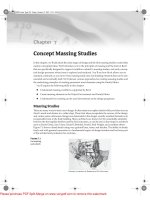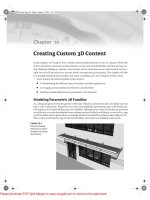Tài liệu COGNITIVE RADIO ARCHITECTURE pptx
Bạn đang xem bản rút gọn của tài liệu. Xem và tải ngay bản đầy đủ của tài liệu tại đây (7.96 MB, 488 trang )
COGNITIVE RADIO
ARCHITECTURE
The Engineering Foundations of
Radio XML
JOSEPH MITOLA III
A JOHN WILEY & SONS, INC., PUBLICATION
COGNITIVE RADIO
ARCHITECTURE
COGNITIVE RADIO
ARCHITECTURE
The Engineering Foundations of
Radio XML
JOSEPH MITOLA III
A JOHN WILEY & SONS, INC., PUBLICATION
This book is printed on acid-free paper.
Copyright © 2006 by John Wiley & Sons, Inc. All rights reserved.
Published by John Wiley & Sons, Inc., Hoboken, New Jersey.
Published simultaneously in Canada.
No part of this publication may be reproduced, stored in a retrieval system, or transmitted in
any form or by any means, electronic, mechanical, photocopying, recording, scanning, or
otherwise, except as permitted under Section 107 or 108 of the 1976 United States Copyright
Act, without either the prior written permission of the Publisher, or authorization through
payment of the appropriate per-copy fee to the Copyright Clearance Center, Inc., 222
Rosewood Drive, Danvers, MA 01923, 978-750-8400, fax 978-646-8600, or on the web at
www.copyright.com. Requests to the Publisher for permission should be addressed to the
Permissions Department, John Wiley & Sons, Inc., 111 River Street, Hoboken, NJ 07030,
(201) 748-6011, fax (201) 748-6008.
Limit of Liability/Disclaimer of Warranty: While the publisher and author have used their
best efforts in preparing this book, they make no representations or warranties with respect
to the accuracy or completeness of the contents of this book and specifi cally disclaim any
implied warranties of merchantability or fi tness for a particular purpose. No warranty may be
created or extended by sales representatives or written sales materials. The advice and
strategies contained herein may not be suitable for your situation. You should consult with a
professional where appropriate. Neither the publisher nor author shall be liable for any loss
of profi t or any other commercial damages, including but not limited to special, incidental,
consequential, or other damages.
For general information on our other products and services please contact our Customer
Care Department within the U.S. at 877-762-2974, outside the U.S. at 317-572-3993 or
fax 317-572-4002.
Wiley also publishes its books in a variety of electronic formats. Some content that appears
in print, however, may not be available in electronic format.
Library of Congress Cataloging-in-Publication Data:
Mitola, Joseph.
Cognitive radio architecture : the engineering foundations of radio XML / by
Joseph Mitola.
p. cm.
Includes bibliographical references and index.
ISBN-10: 0-471-74244-9
ISBN-13: 978-0-471-74244-9
1. Software radio. 2. XML (Document markup language) I. Title.
TK5103.4875.M58 2006
621.384–dc22
2005051362
Printed in the United States of America
10 9 8 7 6 5 4 3 2 1
v
CONTENTS
PREFACE ix
ACKNOWLEDGMENTS xi
1 INTRODUCTION 1
1.1 Perception / 3
1.2 Aware, Adaptive, or Cognitive? / 5
1.3 Adaptation / 8
1.4 Cognition / 10
1.5 Cognitive Radio and Public Policy / 15
1.6 Are We There Yet? / 16
1.7 Key Questions / 18
1.8 Organization of the Text / 19
1.9 Exercises / 20
I FOUNDATIONS
2 TECHNICAL OVERVIEW 25
2.1 The iCR Has Seven Capabilities / 25
2.2 Sensing and Perception: What and Whom to Perceive / 27
2.3 Ideal Cognitive Radio (iCR) Platform Evolution / 41
2.4 The serModel of Machine Learning for iCR / 47
2.5 Architecture / 51
vi CONTENTS
2.6 Synoptic iCR Functional Defi nition / 56
2.7 Exercises / 56
3 EVOLVING FROM AWARE AND ADAPTIVE TO
COGNITIVE RADIO 58
3.1 Revolution or Evolution? / 58
3.2 Moving Day / 59
3.3 Developing AML for Genie / 62
3.4 Learning Etiquette / 73
3.5 Value Proposition for AML in AACR / 75
3.6 Exercises / 79
4 AUTONOMOUS MACHINE LEARNING FOR AACR 80
4.1 Machine Learning Framework / 80
4.2 Histogram as a Discovery Algorithm / 85
4.3 User-Domain Learning / 88
4.4 Radio-Domain Learning / 97
4.5 Reinforcement, Extension, and Constraint Discovery / 108
4.6 Learning Strategies / 118
4.7 Exercises / 121
5 COGNITIVE RADIO ARCHITECTURE 123
5.1 CRA I: Functions, Components, and Design Rules / 124
5.2 CRA II: The Cognition Cycle / 134
5.3 CRA III: The Inference Hierarchy / 138
5.4 CRA IV: Architecture Maps / 143
5.5 CRA V: Building the CRA on SDR Architectures / 144
5.6 Cognition Architecture Research Topics / 152
5.7 Exercises / 152
II RADIO-DOMAIN COMPETENCE
6 RADIO-DOMAIN USE CASES 157
6.1 Radio Use-Case Metrics / 157
6.2 FCC Unused TV Spectrum Use Case / 163
6.3 Demand Shaping Use Case / 170
6.4 Military Market Segment Use Cases / 176
CONTENTS vii
6.5 RF Knowledge That Saves Lives / 177
6.6 Prognostication / 180
6.7 Exercises / 180
7 RADIO KNOWLEDGE 183
7.1 Radio-Domain Overview / 183
7.2 Knowledge of the HF Radio Band / 195
7.3 Knowledge of the LVHF Radio Band / 208
7.4 Radio Noise and Interference / 224
7.5 Knowledge of the VHF Radio Band / 228
7.6 Knowledge of the UHF Radio Band / 237
7.7 Knowledge of the SHF Radio Band / 246
7.8 Knowledge of EHF, Terahertz, and Free Space Optics / 256
7.9 Satellite Communications Knowledge / 260
7.10 Cross-Band/Mode Knowledge / 267
8 IMPLEMENTING RADIO-DOMAIN SKILLS 275
8.1 Cognitive Radio Architecture Structures Radio Skills / 276
8.2 Embedded Databases Enable Skills / 281
8.3 Production Systems Enable Skills / 288
8.4 Embedded Inference Enables Skills / 291
8.5 Radio Knowledge Objects (RKOs) / 296
8.6 Evolving Skills Via RKO and RDH / 303
8.7 Implementing Spatial Skills / 305
8.8 Generalized <Information-landscape/> / 318
8.9 Microworlds / 323
8.10 Radio Skills Conclusions / 325
8.11 Exercises / 326
III USER-DOMAIN COMPETENCE
9 USER-DOMAIN USE CASES 331
9.1 Emergency Companion Use Case / 331
9.2 Offi ce Assistant Use Case / 333
9.3 Cognitive Assistants for Wireless / 334
9.4 User Skill Enhancements / 343
9.5 Exercises / 346
viii CONTENTS
10 USER-DOMAIN KNOWLEDGE 347
10.1 Users’ Natural Language Expression / 348
10.2 Acoustic Sensory Perception / 352
10.3 Visual Sensory Perception / 359
10.4 Audio-Visual Integration / 363
10.5 Lexical Conceptual Semantics (LCS) / 366
10.6 Other Sensors / 369
10.7 Architecture Implications / 369
10.8 Exercises / 369
11 IMPLEMENTING USER-DOMAIN SKILLS 372
11.1 Integrating Cognition / 373
11.2 Autonomous Extensibility / 382
11.3 Supervised Extensibility / 401
11.4 Uncertainty / 407
11.5 Learning Requires Grounding / 417
11.6 Sleep Cycles / 423
11.7 Pitfalls and Opportunities / 424
11.8 Exercises / 426
12 SEMANTIC RADIO 428
12.1 CYC, eBusiness Solutions, and the Semantic Web / 428
12.2 CYC Case Study / 429
12.3 CYC Implications / 437
12.4 Web Languages / 439
12.5 Radio XML / 439
12.6 Conclusions / 443
GLOSSARY 444
REFERENCES 451
INDEX 467
ix
PREF ACE
On 14 October 1998, I coined the term “cognitive radio (CR)” to represent
the integration of substantial computational intelligence—particularly
machine learning, vision, and natural language processing—into software-
defi ned radio (SDR). CR embeds a RF-domain intelligent agent as a radio
and information access proxy for the user, making a myriad of detailed radio
use decisions on behalf of the user (not necessarily of the network) to use the
radio spectrum more effectively. (This is the fi rst of several informal defi ni-
tions of cognitive radio. The technical defi nition is given in a computational
ontology of the ideal cognitive radio, the iCR.) CR is based on “software
radio.” (See J. Mitola, Software Radio Architecture, Wiley, Hoboken, NJ,
2000).
Between 1998 and 2000, I refi ned cognitive radio concepts in my disserta-
tion research. At that time, I built a research prototype cognitive wireless
personal digital assistant (CWPDA) in Java—CR1—and trained it, gaining
insights into cognitive radio technology and architecture. While working on
my dissertation, I described the ideal CR (iCR) for spectrum management at
the Federal Communications Commission (FCC) on 6 April 1999 (see the
companion CD-ROM or web site for the text of this statement) and in a public
forum on secondary markets in a layperson’s version of a core doctoral
program (FCC, Public Forum on Secondary Markets, Washington, DC, 21
May 2000). It showed the potential economic value of iCR in secondary radio
spectrum markets. I fi rst presented the technical material publicly at the
IEEE workshop on Mobile Multimedia Communications (see J. Mitola III,
“Cognitive Radio for Flexible Mobile Multimedia Communications,” Mobile
Multimedia Communications (MoMUC 99), IEEE Press, New York, 1999).
x PREFACE
The FCC uses the term cognitive to mean “adaptive” without requiring
machine learning. This text coins the phrase “ideal cognitive radio (iCR)”
for a CR with autonomous machine learning, vision (not just a camera), and
spoken or written language perception. There will be an exciting progression
across aware, adaptive, and cognitive radio (AACR). Enjoy!
DISCLAIMER
This text was prepared entirely on the author’s personal time and with per-
sonal resources. The author is an employee of The MITRE Corporation on
loan via the provisions of the Interagency Personnel Act (IPA) to the U.S.
Department of Defense (DoD). This document has been “Approved for
public release; Distribution unlimited” per DoD case number pp-05-0378 and
MITRE case number 06-0696. “The author’s affi liation with DoD and The
MITRE Corporation is provided for identifi cation purposes only, and is not
intended to convey or imply MITRE or DoD concurrence with, or support
for, the positions, opinions, or viewpoints expressed by the author.”
Joseph Mitola III
xi
ACKNOWLEDGMENTS
In 1999 and 2000, MITRE Corporation supported the author’s fi nal year of
doctoral research at KTH, The Royal Institute of Technology, Stockholm,
Sweden on which this text is based. The author would like to acknowledge
the truly supportive environment of MITRE, which is a world-class resource
for the creation and application of information technologies for the public
interest.
Without Professor Chip Maguire’s vision, imagination, incredible technical
depth, professional reputation, and unbending support, the cutting edge
research in cognitive radio wouldn’t have happened at all, at least not by me
and not in 1997–2000. KTH and Columbia University couldn’t do better.
Thanks, Chip. Thanks also to Professor Jens Zander, a KTH advisor, who
kept asking all those hard radio engineering questions and offering insights
that have stood the test of time.
Finally, my wife, Lynné, is a saint to have been so supportive not only
through the doctoral work, but in support of my passion for the public benefi t
of radio technology over the decades, starting with teaching in the 1970s,
graduate work in the 1970s and 1980s, my fi rst book—Software Radio Archi-
tecture—in 2000, continuing through the cognitive radio research at KTH,
and fi nally the publication of this book about Aware, Adaptive, and Cognitive
Radio. Lynné not only is the wind beneath my wings, she is my wings. Thanks
for your years of sacrifi ce and support, Hon.
J. M. 3
1
CHAPTER 1
INTRODUCTION
This book is about making radios so smart that they can autonomously dis-
cover how, when, and where to use radio spectrum to obtain information
services without having previously been programmed to do so. Cognitive
radio integrates machine perception software into wireless systems—radio
nodes and networks. Radios today are evolving from awareness (e.g., of loca-
tion) toward cognition: the self-aware radio autonomously learns helpful new
wireless information access and use behaviors, not just sensing the radio fre-
quency (RF) spectrum but also perceiving and interpreting the user in the
user’s environment via computer vision, speech recognition (speech-to-text),
and language understanding (Figure 1-1).
This progression of awareness and adaptation toward cognitive radio
(AACR) leverages traditionally nonradio technologies: computer vision, nav-
igation, speech recognition and synthesis, and the semantic web [1]. Machine
perception grounds the ideal cognitive radio’s “self” and its perception of its
user’s communications needs, priorities, and intent in the world of space,
time, and situation so that the ideal cognitive radio (iCR) more transparently
and effi ciently accesses useful information via whatever wireless means might
be made available. The wireless mantra “always best connected” (ABC) is
transformed by the iCR focus on quality of information (QoI) to “always
better informed” (ABI). This transformation is facilitated by semantic web
technologies like the eXtensible Markup Language (XML) and the Ontology
Web Language (OWL) [2] adapted to radio applications via a new metalan-
guage, Radio XML (RXML).
Cognitive Radio Architecture: The Engineering Foundations of Radio XML
By Joseph Mitola III Copyright © 2006 John Wiley & Sons, Inc.
2 INTRODUCTION
The iCR is a far-term vision. The path suggested in subsequent use cases
evolves increasingly from aware and adaptive radios toward cognitive radio,
the AACR revolution. AACR technology can also power increasingly autono-
mous cognitive wireless networks (CWNs). The cognitive radio architecture
(CRA) defi nes functions, components, and design rules by which to evolve
software-defi ned radio (SDR) toward the iCR vision. The core technology of
the CRA evolution is the <Self/>,
1
defi ned in RXML, perceiving the radio
spectrum, enabling vision and speech perception with embedded autonomous
machine learning (AML) for RF awareness, cooperative networking, and
mass customization of information services for the <Self/>’s own <User/>.
This initial chapter draws important distinctions among similar AACR
concepts and sets the perspective for the balance of the book. The foundation
chapters then further develop the use cases and technical ideas from radio
technology, machine perception, machine learning, and the semantic web,
organizing the approach into the CRA and illustrating this architecture with
the research prototype CR1. The Java source code of CR1 illustrates the
CRA principles in a simulated cognitive wireless personal digital assistant
(CWPDA). Subsequent chapters on radio and user-domain skills develop the
ideas further. Exercises engage the serious reader.
X - Unused Channels
Z - Subscribed Services
I - In Use by Others
B - Broadcast
Perceives Radio Domain
Perceives Scene as User
Vision +
CWPDA
II IIXX
ZZB BXX
I
X
FIGURE 1-1 Notional cognitive wireless personal digital assistant (CWPDA).
1
Terminated XML tags like <Self/> are ontological primitives of Radio XML.
1.1 PERCEPTION
SDRs sense specifi c radio bands but lack broad RF, audio, and visual percep-
tion. Perception technologies enable AACR to autonomously take the user’s
perspective, to understand referents in speech and vision, recognizing QoI
features of both RF and user sensor-perception domains with a goal of zero
redundant instructions from the user to the AACR for information access.
The iCR accesses information as presciently as the legendary Radar O’Riley
of 4077 MASH
®
.
1.1.1 RF Perception
RF perception goes beyond the detection of expected signals on known fre-
quencies. It includes the extraction of helpful information from broadcast
channels, deference to legacy (noncognitive) radios, reduction of noise, and
minimization of interference not just by running the right SDR modules, but
by autonomously constructing the RF behavior most appropriate to the
setting. RF perception enables the iCR to characterize the signifi cant entities
and relationships in the RF environment. RF perception goes beyond the
traditional radio-domain sensing of signal-to-noise ratio (SNR), bit error rate
(BER), code space, and the like. For example, to be most effective in the
recently liberalized U.S. TV spectrum bands, an AACR not only senses
broadcast channels but also computes the likelihood of hidden legacy TV
receivers (“hidden nodes”), for example, based on detection of the TV below
the noise level [3], directing energy away from hidden nodes.
2
Such RF per-
ception grounds the iCR’s <Self/> with its <User/> in the domain (space ×
time × RF). The iCR’s computational models of RF entities include legacy
transmitters, aware–adaptive radios (AARs), iCRs, multipath refl ectors,
sources of noise or interference, and other relevant entities. The continuously
increasing digital hardware capacity per gram enables increased wearable
sensing with embedded RF scene perception from algorithms that model RF
relationships. Thus, spectrum sharing of TV channels can evolve toward the
iCR “radio etiquette,” autonomous polite use of available radio resources
tailored to the situation.
Although it is possible to embed RF sensing and perception in hardware-
defi ned radio, the value proposition of iCR use cases accrues most dramati-
cally via SDR. For example, the iCR negotiates with alternative bearer
networks on behalf of the user, downloading specialized air interfaces, and
validating them before enabling them in the <Self/>’s embedded SDR. The
iCR behaves as an autonomous RF access management agent.
2
This comment relates to an important use case supporting FCC policy referred to as the TV-
spectrum use case.
PERCEPTION 3
4 INTRODUCTION
1.1.1.1 GSM–DECT Priority
Network operators may not see the value of the CWPDA negotiating on
behalf of the user. Sometimes the needs of the user contradict the needs of
the service provider. Researchers have shown user-centric RF behaviors to
be both easy to implement and valuable. For example, in 1997–1999 Ericsson
®
provided dual-mode [4] GSM–DECT (Digital European Cordless Telephone)
wireless badges to KTH, The Royal Institute of Technology at Kista
(pronounced “sheesta”), a suburb of Stockholm. When initialized inside
the Elektrum building, the badges used DECT’s free air time for network
access. As the user lost DECT connectivity elsewhere on campus, the badge
switched to GSM as planned. KTH paid Telia, the GSM service provider, for
air time. Returning to the building, the badges stayed in GSM mode since
GSM propagates well at Elektrum, so the badges rarely switched back to
DECT, which cost the project a bundle, at least on paper. Reprogramming
the badges to reacquire DECT whenever possible avoided the cost of GSM
air time while indoors, reducing cost by a substantial fraction: Telia lost
revenue from the displacement to a free RF band of what could have been
cell phone traffi c.
1.1.1.2 Closer to Home
Past may be prolog. Suppose your 3G cell phone has IEEE 802.11 hot-spot
capability and you have your own 802.11 networks at home and at work.
Would you like your cell phone to switch to your free 802.11 network when
possible, reducing cellular air time? I would. Why have cordless phones at
home or a desk set at work when your 802.11-enabled cell phone can act as a
cordless handset (for free)? Cellular service providers might not smile on such
a phone. The hardware of a 3G hot-spot phone could access your free 802.11
networks, saving cellular air-time costs. The software personality of that cell
phone almost certainly would not allow that, however, for a mix of social,
economic, and technical reasons. But a future AACR with fl exible 802.11
access could use either the for-fee hot spot or your for-free home and
work wireless access points, for example, via Voice over IP (VoIP). An iCR
with suffi cient prior training and AML would not have to be programmed
for that specifi c use case. It would discover the free RF access points through
its ability to perceive the RF environment. It would discover the availability
of your access points and autonomously synthesize a lowest cost (if that is
your criterion) network interface that met your needs. How would the iCR
know your needs? Such knowledge may be based on <Scene/> perception,
the iCR perceiving itself, <Self/>, and its <User/> in a space–time–RF
<Scene/>.
1.1.2 User <Scene/> Perception
Multisensory perception grounds the iCR’s <Self/> and its <User/> to the
everyday world of physical settings with associated events, for example, defi ned
as <Scenes/> in radio XML. Thus, the iCR manages wireless resources as an
information services agent. Such an agent requires real-time perception and
correlation of the current <Scene/> to similar <Scene/>s experienced previ-
ously, indexed effi ciently to infer the <Scene/>-dependent needs of the user.
To detect changes in the user’s communications needs, iCRs perceive the
<Self/> and <User/> in the RF <Scene/> via vision, sound, email, and speech.
The focused leveraging of knowledge representation, spatial–temporal task
planning, and AML enables responsiveness without user tedium or expensive
network customization staffs. AML technology thus offers mass customiza-
tion of iCR behavior. The sharing of knowledge among AACRs on behalf of
their <Users/> creates ad hoc information services without the mediation of
a for-fee service provider. This vision of the self-extending iCR may take
decades to fully mature, but the radio knowledge, mutual grounding, and
open architecture developed in this text assist more rapid technology evolu-
tion in this direction.
1.2 AWARE, ADAPTIVE, OR COGNITIVE?
There is a continuum from SDR to iCR with potentially many discrete steps,
a few of which establish the technical foundation for evolution. Aware radios
(ARs) incorporate new sensors that enhance wireless QoI. Embedding GPS
in a cell phone, for example, enhances location QoI of the cell phone user. If,
in addition, the cell phone assists the user with GPS navigation, then the cell
phone itself is location aware.
Defi nition: A radio entity <Self/> is GPS aware if and only if (iff) an algo-
rithm in the <Self/> uses the GPS data for <RF/> or <User/>-QoI tasks.
As shown in Figure 1-2, the degree of location awareness ranges from
convenient to cognitive.
1.2.1 Convenient
GPS may be embedded, but the radio’s location awareness may be nonexis-
tent: mere integration of GPS into a cell phone with latitude and longitude
displayed is not location awareness. In such a confi guration, the embedded
GPS display has no relationship to the cell phone itself other than sharing the
mechanical enclosure. This product is convenient but is functionally equiva-
lent to a distinct GPS receiver in the user’s other pocket: convenient, but the
radio’s <Self/>
3
is not GPS aware.
3
<Self/> always refers to the radio’s own self-referential data structures and algorithms, not to
a <User/>.
AWARE, ADAPTIVE, OR COGNITIVE? 5
6 INTRODUCTION
1.2.2 Aware
For RF-location awareness, the phone must associate some aspect of <RF/>
with <Location/>. For example, if the network determines the received signal
strength indication (RSSI) at a given location by a query for (RSSI, Location)
from the phone, then it is RF (RSSI)-<Location/> aware. The phone associ-
ates a <RF/> sensory parameter with <Location/> sensed simultaneously.
The phone is user-location aware if it associates some aspect of the <User/>
domain, such as broadcast radio preference, with location. Observations like
(WTOP; Washington, DC) learned by the CWPDA support user-location
awareness. A user-location aware network may associate user behavior, like
placing a call, with user location, for example, to gather statistics on the
space–time distribution of demand. Such user-location awareness enables
better provisioning and thus better grade of service (GoS) [170]. User-
location aware networks are not new.
1.2.3 Adaptive
Adaptivity requires action. Specifi cally, if the phone itself uses location to
optimize RF then the phone is RF-location adaptive. Suppose the phone
could automatically change bands from UHF to VHF not when UHF fades,
but when <Self/> detects a location and direction of movement where UHF
is known to fade based on previous experience. Such a phone is RF-location
adaptive, in this case band adaptive. 3G phones typically are mode adaptive,
switching from a high data rate, high QoS mode to low data rate, stay-
connected modes during periods of weak RSSI.
1.2.4 Cognitive
Suppose the phone had learned RF-location adaptive behavior without having
been preprogrammed. For example, the phone could create a database of
location-indexed RSSI vectors (Latitude, Longitude, Time, RF, RSSI).
Suppose the <Self/> includes a pattern recognition algorithm that detects a
sequence of vectors along which UHF fades deeply for several minutes while
at the same time VHF has strong RSSI. The pattern recognition algorithm
+ GPS Module = Convenient
+ GPS RF = RF-Location Aware
+ GPS + RF Band Control = Adaptive
+ GPS + Autonomous Adaptation = Cognitive
FIGURE 1-2 Wireless PDA plus GPS may be convenient, aware, adaptive, or
cognitive.
might also determine that it takes 300–750 ms for the cell system to switch
bands when UHF fades and that 80% of the time it has lost connectivity in
400 ms. Suppose fi nally that the phone <Self/> decides that to be always best
connected (ABC) it should request handover based on location rather than
on RSSI. ABC is a motto of the European Union (EU) wireless research
Framework program [5]. The phone might report weak RSSI to the network
so it switches bands, not knowing that the phone has strong RSSI but antici-
pates weak RSSI soon. That phone would be exhibiting cognitive behavior
with respect to RF-location because:
1. It observed RF parameters and associated location over time.
2. It associated RF features (e.g., RSSI) with location (i.e., the path over
which UHF fades).
3. It detected a relationship among these data associations and its user’s
need to be connected.
4. It reasoned over time to accurately diagnose that its user was not being
connected because of a timing problem with handover.
5. It took effective action to achieve its goal (i.e., it reported low RSSI to
obtain timely band handover to keep the user connected).
6. It achieved this specifi c behavior from general principles, not from
having been specifi cally preprogrammed for this use case.
Professor Petri Mähönen of RWTH Aachen described a “little experi-
ment” in which he integrated a neural network controller into a cell phone
and GPS to autonomously learn the association among time of day, vehicle
speed, and the location of a long underground tunnel. The phone learned to
turn itself off for the 5 minute tunnel transit to save battery life [6]. Network
operators already may employ similar learning algorithms to optimize their
use of radio resources; what is “best” for the network may not be “best” for
the specifi c user, however.
A cell phone that learns can help the user in ways that do not help the
network. Consider the previous example of the KTH GSM–DECT smart
badge. Suppose the <User/> told the radio, “It costs 1 € per minute to use
GSM, but DECT costs zero, so stay connected, but with cost as low as possi-
ble.” If from this and only this goal, the radio autonomously learns to use
GPS location to switch to DECT when in or near KTH Elektrum, then it is
behaving like an iCR. The cost-aware iCR researches tariffs for the user,
learning that DECT air time is free while GSM is not. This book develops
such entities with perception, planning, decision making, and actions that
enable such implicit programming by communicating <User/> priorities via
human language.
The iCR of the GSM–DECT example must know that the user’s text
“GSM” or utterance “gee ess emm” in the instruction of the prior paragraph
refers to specifi c internal signals and software in its own SDR subsystem that
AWARE, ADAPTIVE, OR COGNITIVE? 7
8 INTRODUCTION
might be designated RF1.gsm.6545.v4, not “GSM.” A method of organizing
such information into categories is called taxonomy. Taxonomy with a com-
prehensive semantics of the domain is called ontology [7]. If “GSM” invokes
a map (<GSM/><RF1 . . ./>) relating the user’s words to the signal path in
the chip set, then the radio <Self/> and the <User/> are mutually grounded
regarding GSM. Formally [8], ontology is an intensional semantic structure
that encodes the implicit rules constraining the structure of a subset of reality.
Therefore, ontology defi nes semantic primitives: data and rules. AACR ontol-
ogy structures the domains of <Space/>, <Time/>, <RF/>, and <Intelligent-
entities/>, especially the <User/> and the iCR <Self/>. To emphasize the
ontological role, semantic primitives in this text use XML-style markup,
<Semantic-primitive/>. Semantic web enthusiasts are developing tags and
ontologies to enhance web access. This emerging semantic web offers founda-
tions, software tools [9], and lessons learned from which the specialized radio
ontology kernel Radio XML (RXML) is defi ned in the companion
CD-ROM.
The (Location, Time, RF, RSSI) association sketched above may be real-
ized in a hardware platform with a mix of application-specifi c integrated
circuit (ASIC), fi eld programmable gate array (FPGA), digital signal proces-
sor (DSP) or general purpose processor (GPP), and associated fi rmware or
software. The physical realization of AACR requires a mix of hardware–
software realizations for behavior that is affordable, effi cient, and fl exible.
The optimal mix changes over time, so this text emphasizes functions and
interfaces, not implementation details.
1.3 ADAPTATION
There may be much value to adaptation without cognition. The aware–
adaptive radio (AAR) is programmed to adapt itself to some aspect of a
<Scene/>.
1.3.1 Adaptation Within Policy
A radio that senses an unused TV channel and adapts its transmission to use
that RF channel for a low power ad hoc network is adapting to spectrum
availability within a predefi ned policy constraint. The DARPA neXt Genera-
tion (XG) program defi ned a language for expressing <RF/> constraints to
fl exibly implement the U.S. Federal Communications Commission (FCC)
rules enabling the use of such TV channels for Part 15 networks [64].
4
Many
of the myriad other ways of adapting AAR RF behavior autonomously are
developed in the sequel.
4
The use case supporting FCC policy is referred to as the XG or TV-spectrum use case.
1.3.2 Adaptation to the User
Radio adaptation is not limited to RF. A radio with soft biometrics such as
face and speech recognition could adapt to an unknown <User/> by protect-
ing the Owner’s data.
When my wireless laptop was stolen, there was nothing but a password
protecting my personal information from abuse. Suppose somewhere deep in
the motherboard were soft biometric models of me at home, at work, com-
muting, and in recreational settings. The thief might hack the password but
might not be able to fool the biometrics. If I were to introduce such a laptop,
say, to my daughter to help her with her homework, the iCR laptop would
adapt its biometric model of <User/> to include <Barb/>, but it should not let
her access my business information without further permission. How can one
create such fl exible yet trusted devices?
Historically, radio engineers have optimized the graphical user interface
(GUI) to classes of users, but not to individual users. Cell phone GUIs are
optimized for mass markets and military radios are optimized for military
environments. As the complexity of function increases, the GUI complexity
continues to increase, particularly in products where the user must set the RF
air interface parameters (“modes”). A military iCR, though, may learn the
“standard operating procedures” (SOPs) of the military user. Bands and
modes for military SOPs may be published in a signal operating instruction
(SOI). Instead of requiring the military user to enter parameter sets for an
arcane SOP/SOI, the military iCR recognizes the user, time of day, and loca-
tion, learned the SOP with the user, accesses the SOI, and offers the following
dialog between Sgt. Charlie and his iCR Sparky:
Charlie: “Hi, Sparky.”
Sparky (recognizing the GI’s voice and face): “Hi, Charlie. The schedule
says today is a training day. Shall I load the SINCGARS training mode
from the SOI?”
Charlie: “OK.”
Sparky: “What’s today’s training password?”
Charlie: “Today we are ‘Second Guessing’.”
Sparky verifi es Second Guessing against the password downloaded via the
Army’s standard Single Channel Ground and Air Radio System (SINC-
GARS) secure network.
5
Charlie does not waste time with radio trivia; if
encumbered with protective gear he doesn’t need to type in the data load,
potentially making an unfortunate mistake. Because of the unrealized poten-
tial of such speech, vision, and soft biometrics technologies, this book empha-
sizes such new iCR GUI ideas [10] with perception and AML to adapt to the
specifi c <User/>, Charlie.
5
This vignette is the SINCGARS–Sparky use case.
ADAPTATION 9
10 INTRODUCTION
1.4 COGNITION
The value proposition of iCR needs further attention. Communications today
are increasingly tedious. Commercial cellular users experience greater QoI
with a briefcase full of GPS, AM/FM broadcast receivers, triband cellular,
VHF push to talk, and cameras. The QoI entails increasingly complex control
made transparent by the GUI (e.g., of cellular networks). But the mutual
incompatibility of wireless PDAs, home wireless networks, business WLANs,
wireless laptops, and so on burdens many users with tedium, limiting market
penetration and decrementing QoI. AACR that perceives the user’s needs
and learns to support them by connecting to information via any feasible RF
eases the burden of complexity, reduces costs, improves QoI, and enhances
market value.
1.4.1 Perceiving User Needs
Is the user jogging or having a heart attack? Multiband cell phones and mili-
tary radios don’t care. But iCR user-perception technologies enable iCR both
to sense such user states and to react, supplying contextually relevant personal
information services, transforming radio from bit pipe to perceptive RF
portal. A wearable iCR that “yells for help” as it detects a heart attack, so a
nearby police offi cer instantly renders fi rst aid, contributes directly to per-
sonal health and wellbeing. A user surprised by a massive heart attack cannot
dial 911. The iCR that can see and hear—sensing heart rate from the mul-
tipath signature of an ultra-wideband (UWB) personal area network (PAN)
to infer the impending heart attack asks <User/>, “Are you OK?” and sensing
gasping and struggling verifi es a health need. The iCR calls for help: “This
is an emergency. I am iCR 555-1212. My owner is having a heart attack. He
is incapable of communicating. This is not a drill. Please send a medical team
immediately.”
Wearable cameras are in mass production. Vision subsystems that perceive
motion via optical fl ow are available in chip-sized focal-plane arrays [256].
Thus, CWPDAs that see what the user sees are not far off. An iCR packaged
as a CWPDA perceives user communications needs to a degree not practica-
ble with today’s radio technology. Some of the technology to make such
behavior affordable and reliable is on the frontiers of computer science, so
this book offers a radio-oriented introduction to these emerging technologies,
suggesting architecture and migration paths for AACR evolution.
1.4.2 Learning Instead of Programming
The iCR might detect other potential sources of bodily harm. To preprogram
all such scenes, the way Sparky was programmed to adapt to SOI, is combi-
natorially explosive. AML of specifi c user-RF needs, sharing among peer
iCRs, and collaboration via CWNs are keys to the mass-customization value









